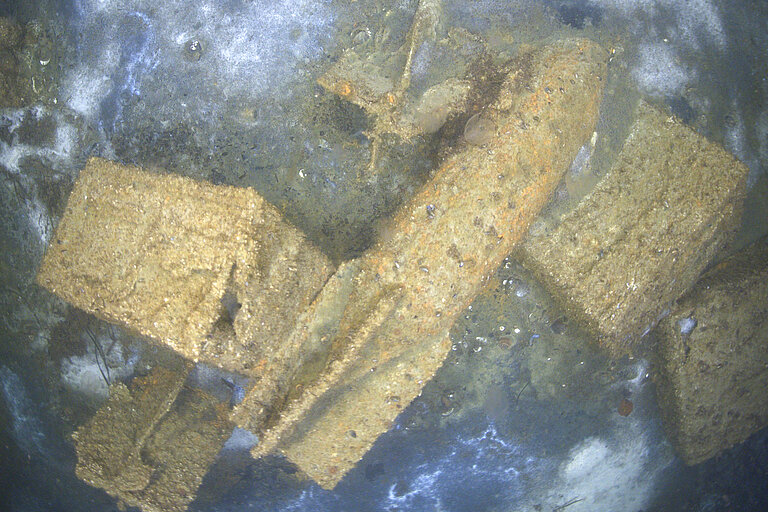Does Underwater Munitions Clearance affect the Marine Environment?
Marine Monitoring and Research in the Bay of Lübeck
Since mid-September, three professional companies have been removing unexploded ordnance (UXO) from a dump site in the Bay of Lübeck. This is the first time that proactive efforts are being made to recover munitions from the sea in order to better understand the challenges and find the most efficient clearance methods. This is pioneering work not only in Germany, but worldwide. “No other country has attempted to recover legacy munitions from the sea on such a large scale,” says Professor Dr Jens Greinert, marine geologist and munitions expert at GEOMAR. “We are absolute pioneers in this field”.
Expedition AL622: Environmental monitoring of munitions clearance
The impact of large scale munition clearance operations on the marine environment is therefore unknown. Researchers will investigate this as part of the AL622 ‘Postclear’ cruise with the research vessel ALKOR. From 14 to 21 October 2024, they will take water and sediment samples in the Bay of Lübeck, sample fish and take video footage with the underwater robot ‘Käpt’n Blaubär’. On board are Professor Greinert, geochemists Dr Aaron Beck and Mareike Keller from GEOMAR, marine biologist Dr Andrey Vedenin from the research institute Senckenberg am Meer and fisheries ecologist Dr Jörn Scharsack from the Thünen Institute.
“We continuously monitor various parameters,” explains Chief Scientist Greinert. “When we are not on site, the salvage companies collect samples, which we then analyse.” The comprehensive environmental analyses are essential to accurately document and assess the potential negative environmental impact of munitions clearance.
Legacy Munitions on the Seabed
It is estimated that around 1.6 million tonnes of legacy munitions from the World Wars lie off the coasts of the German North Sea and Baltic Sea. This environmental threat has been largely ignored for decades, but time is running out. The metal is corroding, and explosives such as the carcinogenic and mutagenic trinitrotoluene (TNT) are already exposed on the seabed. Explosive compounds and their degradation products have been detected in seawater, shellfish, and fish.
In response to this problem, the German Federal Ministry for the Environment, Nature Conservation, Nuclear Safety and Consumer Protection (BMUV) launched an emergency programme last year, allocating €100 million to tackle the problem. The pilot clearance operations in the Bay of Lübeck, which started on 13 September, are funded by this programme.
Bay of Lübeck selected as Pilot Clearance Area
The Bay of Lübeck was selected as a pilot area following a comprehensive risk-benefit analysis. This is a particularly challenging area for clearance: various types of munitions – from cartridges and boxes to 500 kg bombs – are found in complex layers on the seabed. This area will provide valuable insights into the technical requirements and potential hazards, which will be crucial for future recovery projects. “The knowledge gained from this pilot operation will help us to develop an environmentally sound, safe and efficient process for the recovery and subsequent disposal of munitions,” says Greinert.
Expedition at a Glance:
Name: ALKOR Expedition AL266 “Postclear”
Duration: 14 to 21 October 2024
Chief Scientist: Professor Dr Jens Greinert
Research Area: Baltic Sea (Bay of Lübeck)
MUNIMAR: Centre for Munitions Management in the Marine Environment
GEOMAR is the scientific partner in the newly established centre of competence for marine UXO clearance in Schleswig-Holstein (MUNIMAR). The aim of this centre is to coordinate the munitions clearance activities of Schleswig-Holstein in the North Sea and the Baltic Sea and to improve the communication between the different institutions involved, also across national borders. GEOMAR provides scientific expertise to project managers and research institutions, promotes scientific networks, and identifies research gaps.
Research on Legacy Munitions at GEOMAR
Since 2016, GEOMAR has been conducting research on the issue of legacy munitions on the seabed of the German North Sea and Baltic Sea. Special attention is given to the four known munitions dump sites in the Schleswig-Holstein Baltic Sea: two areas in the Bay of Lübeck, the Kolberger Heide near Kiel, and an area near Falshöft outside the Flensburg Fjord.
Among many other projects dealinmg with this issue, Professor Dr Jens Greinert is leading the research project CONMAR (CONcepts for conventional MArine Munition Remediation in the German North and Baltic Sea), which is part of the “Protection and Sustainable Use of Marine Spaces” mission of the German Marine Research Alliance (DAM). The aim of CONMAR is to develop innovative, large-scale, and environmentally friendly concepts for munitions recovery. The project is funded by the Federal Ministry of Education and Research (BMBF) with €4.8 million.

In order to assess and document the environmental impact of the UXO clearance, water samples will be taken in the Bay of Lübeck during the AL622 'Postclear' cruise. Photo: Sarah Kaehlert, GEOMAR

Today, the research vessel ALKOR embarks on an expedition in the Bay of Lübeck. The aim is to study the effects of munitions clearance on the marine environment. Photo: Marc Petrikowski

Clearance operations are particularly challenging in the Bay of Lübeck: different types of munitions lie in complex layers on the seabed. Photo: AUV team, GEOMAR

The underwater robot 'Käpt'n Blaubär' will be used to take pictures and video of the seabed after the pilot UXO clearance. Photo: Maike Nicolai, GEOMAR


